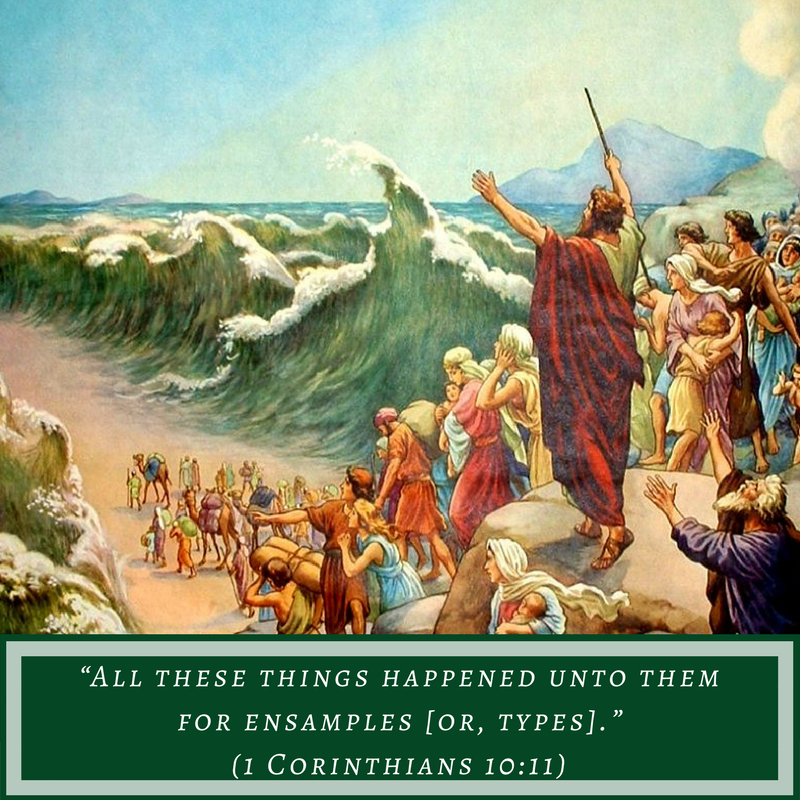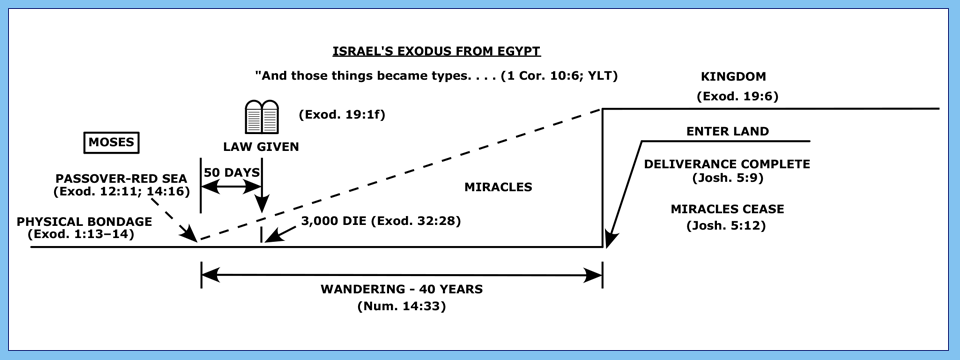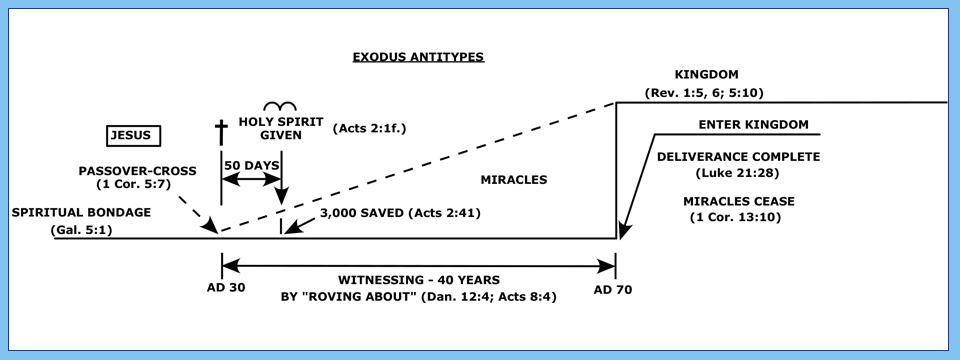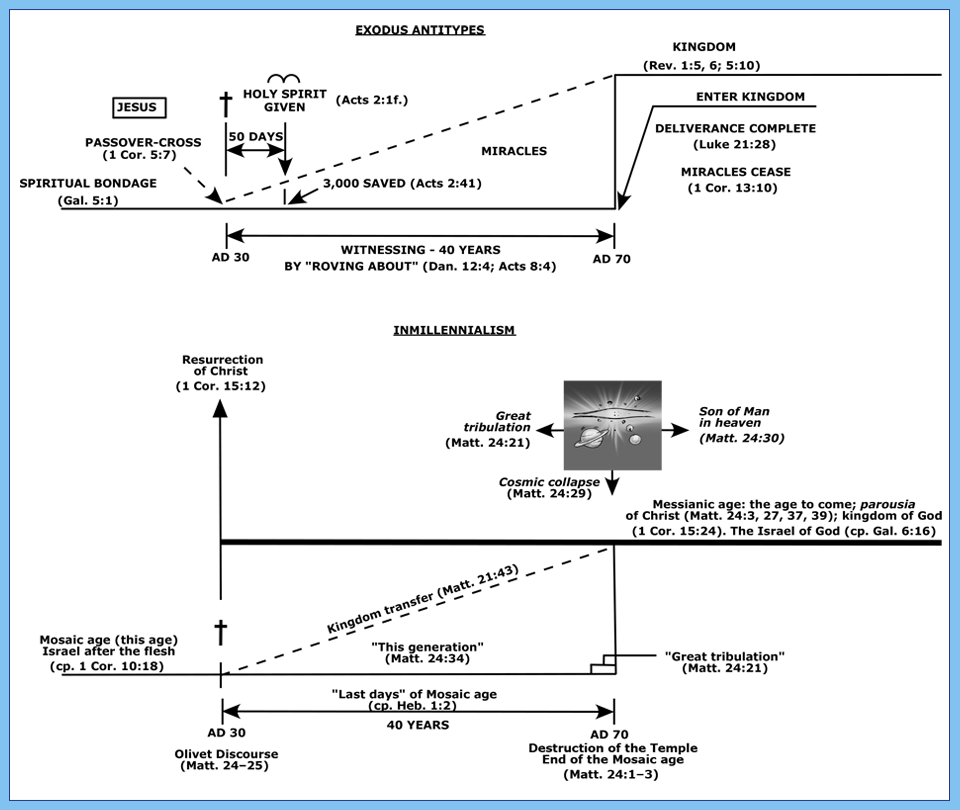
We are exercising our prophetic model, inmillennialism, in Paul’s letter to the Hebrews. The apostle argues for the superiority of God’s revelation in the “last days” of the Mosaic age over others, especially the law. One reason is the superiority of Christ as the agent through whom God gave the new revelation: he transcends the angels through whom the law came (Heb. 1:4 – 2:18). Our last post, Christ Superior to Angels, showed how inmillennialism supports the logic in this section of Hebrews.
Paul will continue by observing that Christ is also superior to Moses (Heb. 3:1 – 4:13). Our next post will apply inmillennialism to that section (D. V.). Paul will use typology to make his case: “And Moses verily was . . . a testimony1 of those things which were to be spoken after” (Heb. 3:5). We will take a brief, preparatory look in this post at typology, emphasizing its role in inmillennialism.2
We admit at the outset that people sometimes misuse typology. The abuses can result in blatant spiritualizing. For example, I once heard of a minister who claimed the “five smooth stones” David placed in his bag (1 Sam. 17:40) represented the five points of Calvinism.3 This is not legitimate typology! Such practices give this interpretive tool an undeserved bad reputation.
Such abuses should not scare us away from this important element in Scripture. We must exercise caution in using typology, but we need it to understand major parts of the Bible. The Scriptures use types in many places: Adam is a type of Christ (Rom. 5:14); the tabernacle Moses erected is a type of “heavenly things” (Heb. 8:5); Noah’s deliverance through the flood is typical of salvation in Christ (1 Pet. 3:20–21); etc.
In this post, we want to lay some typological groundwork that will help us better understand the apostle’s reasoning in Hebrews. Patrick Fairbairn provides a helpful definition of a type:
There are two things which, by general consent, are held to enter into the constitution of a type. It is held, first, that in the character, action, or institution which is denominated the type, there must be a resemblance in form or spirit to what answers to it under the Gospel; and secondly, that it must not be any character, action, or institution occurring in Old Testament Scripture, but such as had their ordination of God, and were designed by Him to foreshadow and prepare for the better things of the Gospel.4
We will also need a working definition of “antitype.” This is “a fulfillment or completion of an earlier truth revealed in the Bible. Baptism in the New Testament, for example, as an expression of one’s salvation, fulfills the function served by Noah’s ark in the Old Testament. Thus, Noah’s ark was a type, and baptism was an antitype (1 Pet. 3:21).”5
We should understand typological inversions. Consider, for example, Paul’s statement that Adam was “the figure (tupos) of him that was to come” (Rom. 5:14). Adam was a type of Christ because he represented a people—all his descendants. He acted on their behalf and determined their destiny by his actions. Christ likewise represented a people—the elect people whom God gave him before the world began (e.g., Eph. 1:4). His actions determined their future.
But there is another side to this typological coin. Paul also emphasized the dissimilarities in this typology:
But not as the offence, so also is the free gift. For if through the offence of one many be dead, much more the grace of God, and the gift by grace, which is by one man, Jesus Christ, hath abounded unto many. And not as it was by one that sinned, so is the gift: for the judgment was by one to condemnation, but the free gift is of many offenses unto justification. (Rom. 5:15–16; emphasis added)
Adam’s act resulted in condemnation; Jesus’ act resulted in justification. The symbol (type) relates to the reality (antitype) by representing its exact opposite; condemnation “represents” justification by typological inversion.
Paul’s list of Exodus types in First Corinthians
Paul uses typology in his first letter to the Corinthian church in a way that will help us interpret Hebrews. Speaking of Moses and Israel’s Exodus from Egypt, he says: “Now all these things happened unto them for ensamples (Gk. tupos; types): and they are written for our admonition, upon whom the ends of the world (Gk. aion; ages) are come” (1 Cor. 10:11).
Most times, to stay on safe ground we must test a proposed type by comparing scripture to scripture while using Fairbairn’s (or a similar) definition. Here, the apostle removes all doubt by an explicit statement—the Exodus events were types of things pertaining to New Testament times.
John Gill notes that the Corinthians were living in the “end of the ages,” by which (according to Gill) Paul means the end of “the Jewish ages, or times of the Mosaic economy.”6 If so, Paul is saying the Exodus events are types and the events during the “last days” of the Mosaic Age are the antitypes.
We hasten to observe that this fits inmillennialism well. It emphasizes the Mosaic-Age-to-Messianic-Age transition during the generation during which Jesus, Paul, and the Corinthians lived. God meant for the Exodus events to give a picture of events that would end the Mosaic age and establish the Messianic Age. The degree to which they do so is remarkable and this tight type-antitype correspondence reinforces inmillennialism.
We can develop a significant list of Exodus types based upon Paul’s statements in 1 Cor. 10:1–11:
- The crossing of the Red Sea (v. 1).
- Israel’s baptism unto Moses under the cloud as they passed through the sea (v. 2).
- God’s supernatural provision of manna and water for their sustenance in the wilderness (vv. 3–4). These represent all God’s miraculous provisions in the wilderness.
- God’s punishment of the people for sins they committed during the Exodus (v. 5). This includes the 23,000 persons who committed fornication (v. 8) and those who murmured (v. 10). It also includes those who were “overthrown in the wilderness” on other occasions (v. 5). For example, three thousand died at the foot of Mount Sinai because of idolatry (Exod. 32:28).
- The forty-year period of wilderness wanderings during which these things happened (v. 5).
Paul listed some of the antitypes in the immediate context. The manna was typical of “spiritual meat” (v. 3). The rock that brought forth water “was Christ” (v. 4), the type being said to be what it represented.
Paul was following Jesus’ lead by interpreting these types in this manner. Jesus said he was “the true bread of life,” the reality represented by the typological manna (John 6:30–35). He identified himself as the antitype of the rock that provided water in the wilderness during the Exodus (John 4:10, 14; 6:55; 7:37).
Paul used this typology to teach the Corinthians not to murmur. Their antitypical situation corresponded to the typical experiences of Israel in the wilderness (1 Cor. 10:10). They should learn to not murmur through this typology.
Expanding Paul’s Exodus list
Other Scriptures expand Paul’s list of typological Exodus events in First Corinthians 10. The Passover served as a type. God instituted this observance the night before the Exodus (Exod. 12:13) to represent Christ’s future sacrifice. Now, says Paul, “Christ our passover is sacrificed for us” (1 Cor. 5:7).
The Tabernacle Moses built during the Exodus (Exod. 35:29f) was a type of “the true tabernacle, which the Lord pitched, and not man.” It served as “the example and shadow of heavenly things” because it was “the pattern (tupos; type)” God showed him on Mount Sinai (Heb. 8:2, 5).
These are clear examples of Exodus typology. In light of this, Paul’s inclusion of Moses himself as a type of Christ in our upcoming passage—Heb. 3:5–6—is not surprising.
There are other, less explicit types in the Exodus events. For example, Israel’s redemption from Egypt is a type of Christ’s redemption of his people from sin and bondage to the law (cp. Gal. 4:24; 5:1). The Egyptian enslavement of Israel shows sin’s mastery over mankind on a physical level (Acts 7:6–7; Rom. 8:14–15). Paul spoke to the Romans about spiritual slavery. They “were once the slaves of sin,” but they had now been “set free from sin” (Rom. 6:17–18, ESV). Jesus had paid a ransom—the “price for redeeming or liberating slaves”7—to rescue them (e.g., Matt. 20:28) as God had redeemed Israel from Egypt (e.g., Deut. 7:8; Isa. 43:3; 51:10). The type-antitype relationship is clear, even though Scripture never declares it using the word for type (tupos).
We can conclude that God establishing the new covenant in Jesus’ generation was the antitype of the giving of the law-covenant in Moses’ generation (Heb. 8:6–13). The replacement of the Mosaic law by what Paul called the “law of the Spirit of life” (Rom. 8:2) was the type being superseded by its antitype.
Diagram of Exodus events
The following diagram depicts the major types in Israel’s Exodus from Egypt:

The above discussion has dealt with most of the elements in this chart. A few require added remarks.
The diagram’s elevation of Israel’s kingdom life in the Promised Land shows their improved status under the Mosaic covenant. Life in their new situation exceeded their earlier existence in Egyptian slavery in every way.
Scripture does not mention the fifty-day interval between the crossing of the Red Sea and the giving of the law. This is a Jewish tradition, “it being a generally received notion that the law was given 50 days after the passover.”8 This unwritten oral history does not contradict Biblical testimony. Moses said God gave the law “in the third month” after Israel left Egypt (Exod. 19:1). This makes the tradition workable. The antitype, as we will soon see, supports this fifty-day tradition.
The diagram’s notation that God had completed Israel’s deliverance when (and only when) they entered the land rests on clear testimony. After crossing the Jordan River, the people camped at Gilgal. There, the Lord commanded Joshua to circumcise the people born in the wilderness. When he finished this task, “the LORD said unto Joshua, This day have I rolled away the reproach of Egypt from off you” (Josh. 5:9). Their redemption from Egypt was incomplete until they entered the land.
Joshua recorded another significant event at Gilgal:
And the children of Israel encamped in Gilgal, and kept the passover on the fourteenth day of the month at even in the plains of Jericho. And they did eat of the old corn of the land on the morrow after the passover, unleavened cakes, and parched corn in the selfsame day. And the manna ceased on the morrow after they had eaten of the old corn of the land; neither had the children of Israel manna any more; but they did eat of the fruit of the land of Canaan that year. (Josh. 5:10–12)
We infer the other on-going miracles that had sustained Israel in the wilderness ceased, too. This does not mean miracles ceased altogether—God soon made the walls of Jericho fall!—but the regular occurrence of miracles no longer characterized Israel’s daily life once they entered the Promised Land.
One final note about the diagram. God told Israel he had redeemed them from Egypt in order for them to be “a kingdom of priests, and an holy nation” (Exod. 19:6). Their deliverance from bondage established a new kingdom.
Type-Antitype Comparison
Let’s compare Paul’s types to their antitypes. We begin with two diagrams, the first showing the types and the second the antitypes.


Jesus came to deliver his people from spiritual bondage, just as Moses came to deliver Israel from physical bondage. He did this through his sacrificial death on the cross. He became our Passover and led the true Exodus.
Fifty days after our Exodus in Christ, God poured out the Holy Spirit on the church. This was the antitype of God giving the law to Moses. Typological inversion is at work here: the law brought death (Rom. 7:10), but the Spirit brought life (Rom. 8:2). Three thousand died at the foot of Mount Sinai where Moses received the law fifty days after passing through the Red Sea (Exod. 32:28). This was the type. The same number lived—gained spiritual life—on the day of Pentecost, fifty days after the Romans crucified Christ (Acts 2:41). This was the antitype.
Israel wandered in the wilderness forty years as a punishment for their unbelief of the gospel (Num. 14:34; Heb. 4:2). The (inverted) antitype was the “wandering” of the church across the Roman empire preaching the gospel in obedient faith for forty years (AD 30–70). This also fulfilled Jesus’ sign that the disciples would preach the gospel “for a witness unto all nations” before the end of the Mosaic Age (Matt. 24:14; Rom. 10:18; Col. 1:5–6).
Just as God sustained Israel for forty years in the wilderness by supernatural miracles, so the church experienced supernatural manifestations of God’s Spirit confirming the apostles preached word (Heb. 2:4). At the end of the forty years, the church was in the heavenly kingdom (Matt. 16:28). This fulfilled the type—Israel’s presence in her earthly kingdom after forty years (Exod. 19:6). Redemption was incomplete, in an important sense, for one generation for both Israel after the flesh (Josh. 5:9; cp. 1 Cor. 10:18) and the Israel of God (Luke 21:28; cp. Gal. 6:16). Just as the wilderness miracles ceased when Israel entered their kingdom (Josh. 5:12), so routine miraculous gifts ceased in the church “when that which is perfect” (i.e., the kingdom age) came in fulness (1 Cor. 13:10). The wilderness miracles were the types, the apostolic miracles the antitypes.
The degree to which the Exodus types find their antitypes in Jesus’ generation is remarkable. Such correspondence of historical events in two generations separated by about 1,500 years cannot be accidental. Events of the earlier period serve as perfect types of those in the latter. The antitypes answer precisely to the types. The Exodus events must have “had their ordination of God, and were designed by Him to foreshadow and prepare for the better things of the Gospel.”9
Inmillennialism and Typology
Inmillennialism accommodates these types and antitypes in a natural and logical manner as the following two diagrams show. The first diagram shows the antitypes and the second a simplified version of inmillennialism.

No type or antitype appears out of place in this prophetic model.
Our prophetic model rests on the Jewish two-age paradigm. For Jesus’ generation, the “existing age” was the Mosaic Age and the “age to come” was the Messianic Age. W. D. Davies underscores the typology inherent in this view:
The Age to Come came to be regarded as a return to two previous periods which might be regarded as “ideal,” namely, the period of the sojourn in Paradise, and that when Moses lived, and the principle came to be established that the last Redeemer would correspond to the first. The marks of the Mosaic period would find their counterpart in the Age to Come.10
John Tindall Harris also observed this two-age perspective and the typology surrounding it:
Just as there had been of old a period of probation in the wilderness of forty years before the entrance into the typical rest of the land of promise, so before the close of the Jewish period, and the coming in of the everlasting righteousness of the New Covenant in the advent in glory of the Lord Jesus, there was again a forty years’ period of probation.11
Inmillennialism is consistent with such statements.
Conclusion
Scripture emphasizes the importance of Exodus types and antitypes. Both Jesus and his apostles reinforce their significance. In both type and antitype, the people of God are in a desperate condition. God delivers them by a gracious act of his power. He then elevates them to a far superior condition through a series of events over a forty year period—one generation (cp. Matt. 24:34).
The implications of these typological connections are far-reaching. As we have noted, Paul will incorporate them into his argument for the superiority of Jesus compared to Moses.
We might add that our evaluation of prophetic systems should include an analysis of how well these types and antitypes fit within them. Lord willing, our next post will apply inmillennialism’s understanding of typology to the next section of Paul’s letter to the Hebrews.
Footnotes
- Paul uses the Greek word marturion (testimony) here, not tupos (type). Even so, typology is involved in this line of reasoning per John Gill, An Exposition of the Old and New Testaments, The Baptist Commentary Series (Paris, AR: The Baptist Standard Bearer, 1989), 9:389.
- The drawing, Crossing the Red Sea, is by Otto Semler and is in the public domain.
- Those of the opposing theological camp might say the stones represented the five points of remonstrance presented by James Arminius as his objections to standard reformed doctrine. Without well-defined interpretive guidelines, who could decide between these two proposals?
- Patrick Fairbairn, Typology of Scripture, (Grand Rapids, MI: Kregel, 1989), 1:46.
- Ronald F. Youngblood, F. F. Bruce, and R. K. Harrison, Thomas Nelson Publishers, eds., Nelson’s New Illustrated Bible Dictionary (Nashville, TN: Thomas Nelson, Inc., 1995), s.v. “antitype.”
- Gill, Exposition, 8:674.
- Walter A. Elwell and Philip W. Comfort, Tyndale Bible Dictionary, Tyndale Reference Library (Wheaton, IL: Tyndale House, 2001), 1111.
- Gill, Exposition, 1:421.
- Fairbairn, Typology, 1:46.
- W. D. Davies, Torah in the Messianic Age and/or the Age to Come, Journal of Biblical Literature Monograph Series (Philadelphia: Society of Biblical literature, 1952), 10. Emphasis added.
- John Tindall Harris, The Writings of the Apostle Paul With Notes, Critical and Explanatory, vol. 1, (London: Headley Brothers, 1901), 118-19. Emphasis added.

2 comments
Another excellent article Mike – well done!
Thank you for your continued support and encouragement.